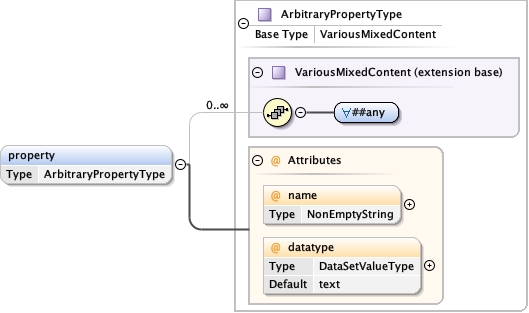<xs:element name="id">
<xs:annotation>
<xs:documentation xml:lang="nl-NL">Met id geeft u toelichting op diverse ID's in relatie tot het project. Meestal tenminste een betekenis (designation), maar mogelijk ook alleen een koppeling met een bepaalde eigenschap zoals een FHIR URI.</xs:documentation>
<xs:documentation xml:lang="en-US">With id you give more information about ID related to the project. Usually at least a designation, but potentially also just an association with a property such as a FHIR URI</xs:documentation>
<xs:documentation xml:lang="de-DE">With id you give more information about ID related to the project. Usually at least a designation, but potentially also just an association with a property such as a FHIR URI</xs:documentation>
</xs:annotation>
<xs:complexType>
<xs:sequence>
<xs:element ref="designation" minOccurs="1" maxOccurs="unbounded"/>
<xs:element name="property" type="ArbitraryPropertyType" minOccurs="0" maxOccurs="unbounded">
<xs:annotation>
<xs:documentation xml:lang="nl-NL">Id eigenschappen bijvoorbeeld voor het verbinden van dit id met andere typen identificatie (bijv. HL7 FHIR Systeem URI) voor hetzelfde object (codesysteem, OID-tak, identificatiesysteem). Als u van plan bent een HL7 FHIR System URI te verbinden die de voorkeur heeft boven de OID, gebruikt u dan @name='HL7-FHIR-System-URI-Preferred'. Als er wel een HL7 FHIR System URI bestaat maar deze niet de voorkeur heeft boven de OID, gebruikt u dan 'HL7-FHIR-System-URI'. Op deze manier herkent ART-DECOR deze indien van toepassing.</xs:documentation>
<xs:documentation xml:lang="en-US">Id properties for example to connect this id to other types of identifiers (e.g. HL7 FHIR System URI) for the same object (code system, OID branch, identification system) If you intend to connect an HL7 FHIR System URI that is preferred over the OID, please use @name='HL7-FHIR-System-URI-Preferred'. When you connect an HL7 FHIR System URI that exists but is not preferred over the OID, please use 'HL7-FHIR-System-URI'. This way ART-DECOR can pick it up if appropriate.</xs:documentation>
</xs:annotation>
</xs:element>
</xs:sequence>
<xs:attribute name="root" use="required" type="Oid"/>
<xs:attribute name="extension" type="EnumerationString"/>
<xs:attribute name="assigningAuthority" type="LongDescriptiveName"/>
</xs:complexType>
</xs:element>
|

